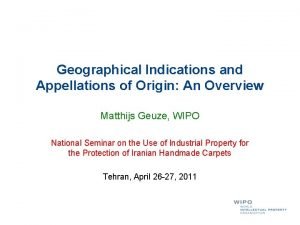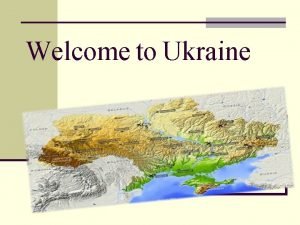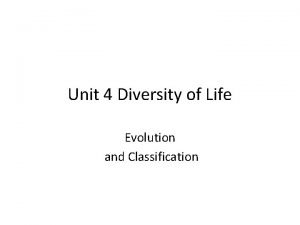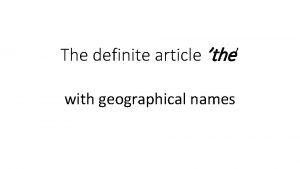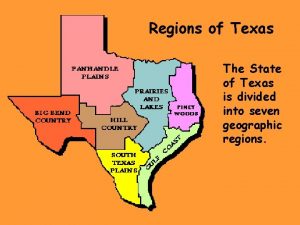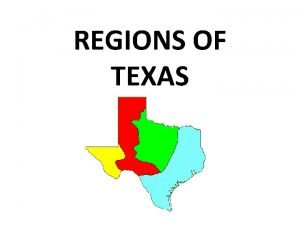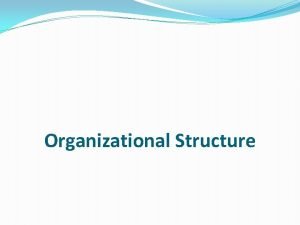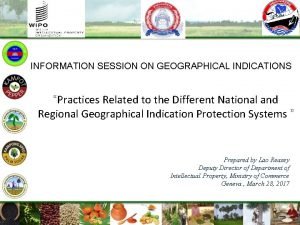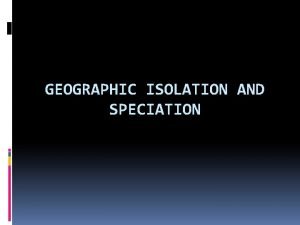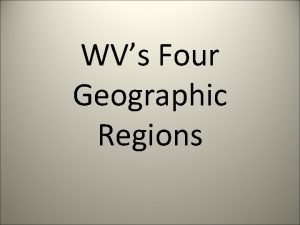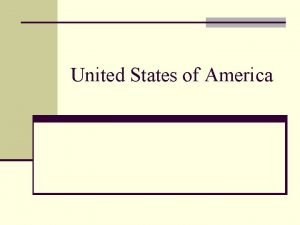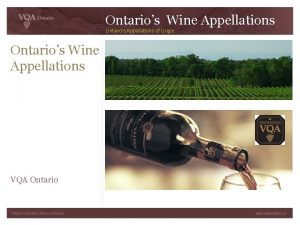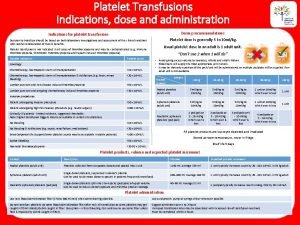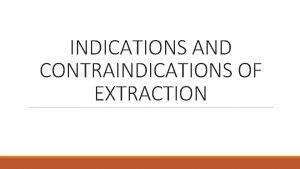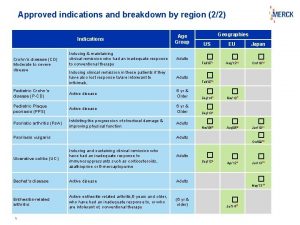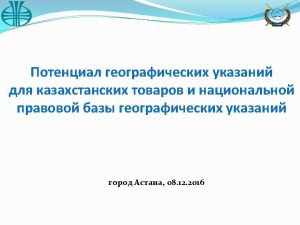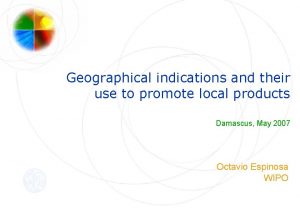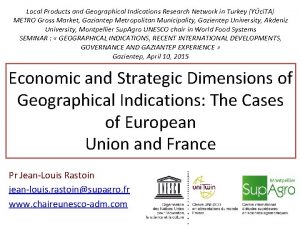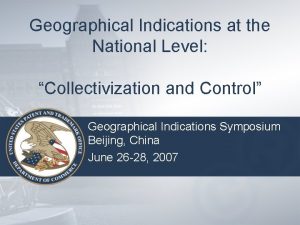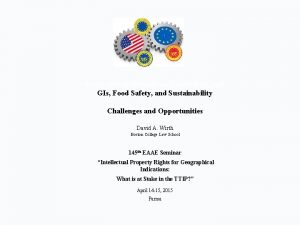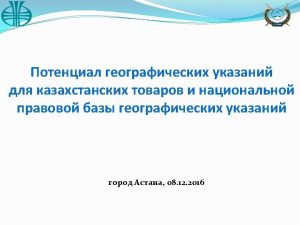Geographical Indications and Appellations of Origin An Overview
























- Slides: 24

Geographical Indications and Appellations of Origin: An Overview Matthijs Geuze, WIPO National Seminar on the Use of Industrial Property for the Protection of Iranian Handmade Carpets Tehran, April 26 -27, 2011

Geographical Indications (GI) and Appellations of Origin (AO) WIPO’s Role Administration of several international agreements relevant for the protection of GIs/AOs Forum for discussion of possible ways to improve the international protection of GIs/AOs Ø Standing Committee on the Law of Trademarks, Industrial Designs and GIs Ø Working Group on the Development of the Lisbon System Provision of technical assistance

Subject-Matter of Protection (GIs and AOs) Indication of a Connection between Characteristics of Products and their Geographical Origin Informs consumers of the uniqueness of the products derived from this connection (typicality) Represents the collective goodwill derived from this uniqueness (reputation) Value-added

Distinctive Signs for Individual Use Trademarks (goods & services) Distinctive Signs for Collective Use Collective marks Certification marks Geographical indications Appellations of origin





Regional systems of protection (EU) Pecorino Romano (PDO) Arroz del Delta del Ebro (PDO)

Examples of Certification Trademarks

Collective Marks

Indications of Source 'Swiss', 'Swiss Quality', "Made in Switzerland', 'Swissmade' or other designations which contain the Swiss name as well as its translation in other languages (can only be used exclusively for products manufactured in Switzerland services from Switzerland)

Why protect GIs and AOs? Benefits for the producers: differentiation and marketing tool, improved livelihood (quality products sold at a premium price) Benefits for the consumers: reduced search costs, guarantee to acquire unique high quality products Benefits for rural areas: stimulate rural development, value socio-cultural and agro-ecological characteristics of a particular place (help sustain production of traditional products) Benefits for regions and countries: positive spillover effects (tourism, additional income, improved reputation)

Different systems of protection worldwide Ø Multilateral Agreements Protection of GIs under TRIPS Protection of AOs under the Lisbon Agreement -Legal protection they provide is based on various means of protection at the national level: an act of public law (law, decree, administrative decision, ordinance), or a judicial decision Ø Regional Systems of Protection (EU, OAPI…) Ø Bilateral Agreements Under such agreements two States or two trading partners agree to protect each other’s GIs or AOs Ø National Laws General laws focusing on business practices (unfair competition and consumer protection provisions) Specific protection systems for GIs and AOs (sui generis) Trademark law provisions devoted to collective marks and/or certification and guarantee marks Administrative schemes of label control

Differences between AOs and GIs AOs (Lisbon, Art. 2) Geographical denomination Recognized as referring to quality or characteristics of a specific product Due exclusively or essentially to the geographical environment (natural or human factors) AO= Special category of GI Only existing multilateral registration system for the protection of AOs GIs (TRIPS, Art. 22. 1) Indication Identifies a good with a specific quality, reputation, or other characteristic Essentially attributable to its geographical origin Symbol referring to or associated with a particular geographical area (e. g. the cartographic outline of France with a red itinerary for Burgundy wines)

How to approach the establishment of a GI or an AO? Determine whether the product in question can be sufficiently differentiated in the market place by the use of a geographical identifier (feasibility analysis of its marketability) v in the country of origin as well as abroad Determine whether stakeholders are interested in a long term commitment v in terms of cooperation and resources If so, then ensure broad participation and leadership Ø to reduce disharmony and ensuing difficulties; and Ø to permit optimal benefits to the stakeholder On this basis, secure development and promotional funds, to meet basic costs Then, engage in the determination of … v the quality or process requirements to apply; v the demarcation of the area of production; v a marketing strategy; and v means to ensure supply chain integrity

What basic costs can a GI or an AO expect to incur? Costs for determining whether the GI or AO in question is viable v interesting product? interested market? organized producers? Investment for establishing the necessary domestic legal structures and defining the exact physical boundaries of the production area and production requirements Information and promotion costs Ø in the country of origin and abroad Costs for registration as a GI or AO v domesticly and abroad Ø sui generis title of protection? Ø collective or certification mark? Costs for monitoring proper use of the GI or AO Reserves for the use of legal enforcement procedures Ø popular products are liable to be counterfeited

Technical Assistance Drafting Legislation Application Criteria for Establishment GI or AO Monitoring and Enforcement Procedures Protection under International Treaties

Overview of the international instruments related to the protection of GIs/AOs Paris Convention (1883) Madrid Agreement (1891) (repression of false and deceptive indications of source) Madrid Agreement and Protocol (1891, 1989) (international registration of marks) Lisbon Agreement (1958) Bilateral Agreements TRIPS Agreement (1994)

On-going Negotiations in the WTO Article 23. 4 of the TRIPS Agreement In order to facilitate the protection of GIs for wines, negotiations shall be undertaken in the Council for TRIPS concerning the establishment of a multilateral system of notification and registration of GIs for wines eligible for protection in those Members participating in the system. (Spirits added by the Doha Ministerial)

Doha Declaration Paragraph 18 completion of the work started in the TRIPS Council on the implementation of Article 23. 4 negotiate the establishment of a multilateral system of notification and registration of GIs for wines and spirits by the 5 th Ministerial Conference issues related to the extension of Article 23 protection to other products will be addressed in the TRIPS Council pursuant to paragraph 12 of this Declaration

Working Group on the Development of the Lisbon System In September 2009, the Assembly of the Lisbon Union: (i) approved amendments to the Regulations under Lisbon Agreement, as recommended by the Working Group (ii) agreed that the WG continue with its review of the Lisbon system (ii) noted that WIPO would conduct a survey among interested stakeholders and explore what changes to the Lisbon system might allow a wider membership (iii) noted that WIPO would prepare a study on the relationship between regional systems of protection for GIs and the Lisbon system (and an analysis of conditions for possible accessions to the Lisbon Agreement by intergovernmental organizations administering such systems)

Working Group on the Development of the Lisbon System (August 30 to September 3, 2010) q The WG requested WIPO to prepare draft treaty provisions on various topics, notably: Ø Ø Ø Definitions Scope of protection Prior use Applications for trans-border AOs or GIs Accession criteria for IGOs q Alternative versions q Revision Lisbon Agreement? New treaty? q Study on the possibility of dispute settlement within the Lisbon system

THANK YOU matthijs. geuze@wipo. int
 Geographical indication and appellation of origin
Geographical indication and appellation of origin Continents without names
Continents without names Geographical names with and without the
Geographical names with and without the Ukraine geographical position
Ukraine geographical position Binomial nomenclature
Binomial nomenclature Registration process of geographical indication
Registration process of geographical indication Registration of geographical indication
Registration of geographical indication Geography of the southeast region
Geography of the southeast region Nature of geographic data
Nature of geographic data The with geographical names
The with geographical names Piers in architecture
Piers in architecture Seven regions of texas
Seven regions of texas Texas geographic regions
Texas geographic regions Physical features of bangladesh
Physical features of bangladesh Strategy department structure
Strategy department structure What are the 7 geographical concepts
What are the 7 geographical concepts Registration process of geographical indication
Registration process of geographical indication What is geographic isolation
What is geographic isolation France absolute location
France absolute location Greece geographical features
Greece geographical features Geographical map of ancient egypt
Geographical map of ancient egypt Potomac section ethnic groups
Potomac section ethnic groups Geographical position usa
Geographical position usa 6 stages of geography fieldwork
6 stages of geography fieldwork Proper adjective of texas
Proper adjective of texas
